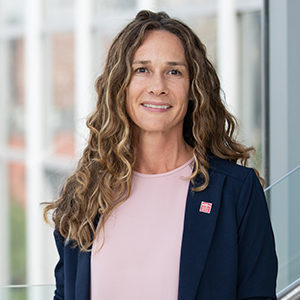Twenty-five leaders from across the University gathered July 17-18 at Podium Karting in Denver to discuss student success, set budget priorities and share in professional development. The annual strategic-planning session sets the stage for the coming year and helps ensure that priorities are aligned across divisions.
President Janine Davidson, Ph.D., launched the two-day session with a look back at enrollment, emphasizing that the University is at an inflection point. To improve metrics of student success, the University needs to double down on strategies most likely to increase retention and completion and achieve the aim of preparing Coloradans for the modern workforce. Initial efforts to “stop the drop” have begun to bend the enrollment curve, and the data reveal where the biggest areas of opportunity are along a student’s journey. Davidson emphasized that after recovering and stabilizing the University following the pandemic, we are on speed to launch MSU Denver and fully operationalize the Strategic Plan. She challenged the team to set goals and track metrics in preparation for launch and reiterated the strong vision and great leaders in place to achieve goals and help everyone realize roles in the plan.
Evidence of student success
Laying out the evidence-based foundation for institutional strategy, EAB consultants, who specialize in education technology and research, presented student-success best practices, which included:
- Removing registration and financial barriers: Implementing strategies such as multiterm scheduling, withdrawal surveys and proactive emergency grants with priority for seniors has been shown to boost completion.
- Supporting course completion: Implementing standardized early and frequent low-stakes assessment and providing supplemental instruction and automated course behavior alerts coupled with automated advising improves course completion.
- Flexibility: Varying course times, lengths and on- and off-ramps and on-demand student support have been proved to support retention.
- Employment preparation: Offering early career advising, industry apprenticeships and stackable credentials plus integrating future professional skills into course content improves job placement and readiness.
Launching student success
Marie Mora, Ph.D., interim provost and executive vice president for Academic Affairs, and Will Simpkins, Ed.D., vice president for Student Affairs, led vibrant discussions on the primary lines of effort that will have the most impact on our student retention and completion, such as:
- Enhancing students’ sense of belonging
- Faculty incentive structure, scheduling
- Workloads
- Tech-enabled advising
- Aligning curriculum and coursework to student career goals
- Providing opportunities for industry-aligned micro- and stackable credentials
- Prior learning and max transfer credit
After collecting vital input from faculty and staff members, Mora, Simpkins and Director of Strategy Meredith Jeffers, Ph.D., will work with deans and other leaders to produce a three-year plan of action designed to improve key student-success indicators.
Setting budget priorities
Outlining a strategic approach to budgeting, Chief Financial Officer Jim Carpenter shared three primary principles, with an emphasis on strategic, aligned prioritization:
- Level 1: Keep expenditures lower than revenues (ideally with reserves and investment).
- Level 2: Direct resources to strategic purposes, prioritized based on the president’s guidance.
- Level 3: Collect data to drive continuous improvement, prioritization and high performance.
Input will be compiled and incorporated into Budget Assumptions and Presidential Budget Priorities, which are set to be released as part of the fiscal 2025 budget-development cycle this summer.
Other key sessions were held on championing change management, approaching crucial communication and equity in higher education.
The semiannual off-site meeting is part of the University’s strategic– planning process, with the next iteration tentatively scheduled for January.


